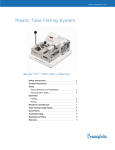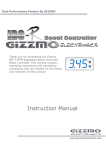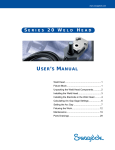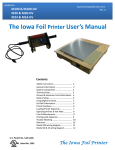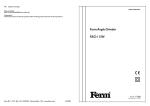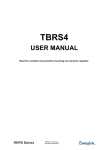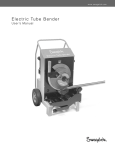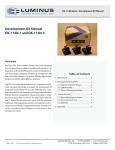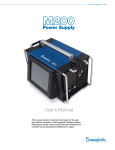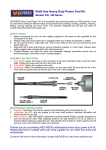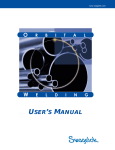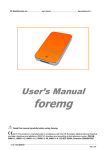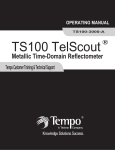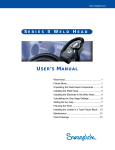Download Tube Facing Tool User`s Manual (SWS-MANUAL-232EP
Transcript
www.swagelok.com TUBE FACING TOOL USER’S MANUAL The Swagelok Limited Lifetime Warranty Swagelok hereby warrants to the purchaser of this Product that the non-electrical components of the Product shall be free from defects in material and workmanship for the life of the Product. All electrical components installed in or on the Product are warranted to be free from defects in material and workmanship for twelve months from the date of purchase. The purchaser’s remedies shall be limited to replacement and installation of any parts that fail through a defect in material or workmanship. MANUFACTURER SPECIFICALLY DISAVOWS ANY OTHER REPRESENTATION, EXPRESS OR IMPLIED, WARRANTY, OR LIABILITY RELATING TO THE CONDITION OF USE OF THE PRODUCT, AND IN NO EVENT SHALL SWAGELOK BE LIABLE TO PURCHASER, OR ANY THIRD PARTY, FOR ANY DIRECT OR INDIRECT CONSEQUENTIAL OR INCIDENTAL DAMAGES. Table of Contents Safety Precautions and Information .........................................................................................................2 Identification of Components....................................................................................................................3 Setup Installing or Relocating the Cutting Insert....................................................................................4 Cutting Insert Position Chart........................................................................................................5 Collet Change and Installation.....................................................................................................7 Operation Motor Settings for Non-Guarded Trigger .....................................................................................8 Cutting Techiniques with Speed and Feed Charts ......................................................................9 Facing the Tube.........................................................................................................................10 Bench Mount Stand................................................................................................................................12 Special Adjustment Features .................................................................................................................13 Spare Parts and Accessories.................................................................................................................14 Ordering Information Collets and Inserts ...............................................................................................14 Assembly Drawing .................................................................................................................................15 CE Declaration of Conformity.................................................................................................................16 Warranty Information Form ....................................................................................................................17 About The Tube Facing Tool Installing or Relocating The Cutting Insert Your facing tool has been shipped with a cutting insert in position number 1. If you will be facing tubing larger than 3/4 in. (18 mm) O.D. you will need to relocate the cutting insert to a different pocket. Cutting insert life is dependent upon tube material, tube diameter, depth of cut, and operational technique. Collet Change and Installation The tube facing tool cuts a wide range of diameters through the use of tube collets. Two collet halves per size are required and must be ordered separately. (See Chart B on page 14) Motor Settings The facing tool is driven by a heavy-duty industrial motor. There are three control knobs that must be set properly to maximize the performance of the facing tool. Facing The Tube As you prepare to face your tubing there are some factors to consider. The method used to cut the tubing may affect the amount of material needed to be removed. The facing tool has been designed to allow for a random amount of material removal if finished length is not critical. You can also control the amount of material removed if the finished length is important. Bench Mount Stand The bench mount stand does not require any tool to remove or secure the facing tool. The base plate will accommodate permanent bench mounting. Spare Parts and Accessories Spare part and accessories can be ordered as needed through your Swagelok sales representative. SAVE THESE INSTRUCTIONS –1– SAFETY PRECAUTIONS The following is a list of general safety guidelines to be considered when operating this tool. Standard safe machining practices should always be observed when operating this tool. Before operating this tool, read this User’s Manual completely. Inspect tool, cord, and accessories for damage prior to operating. Safety guards have been installed for your protection. DO NOT OPERATE TOOL WITHOUT SAFETY GUARDS IN PLACE. The motor should always be disconnected from the power source whenever servicing the unit or changing cutting inserts, collets, or other components. Refer to the operating/instruction manual for specific safety and operating instructions for the motor included with this tool. SAFETY INFORMATION WARNING! MOVING PARTS. Keep hands, loose clothing, and long hair away from rotating or moving parts. Unplug equipment prior to adjusting or servicing. Serious injury can occur. WARNING! ELECTRICAL SHOCK. Read all enclosed safety instructions and manuals prior to operation. WARNING! KEEP DRY. Equipment and components are not waterproof. WARNING! FIRE OR EXPLOSION. Do not use equipment in a combustible or explosive atmosphere. WARNING! EYE PROTECTION. Eye protection must be worn while operating or working near the equipment. CAUTION! EAR PROTECTION. Ear protection may be required if operating or working near the equipment for prolonged periods of time –2– Identification of Components R/Min/Speed Adjustment 2 Spare Torx® Screws (For use with cutting inserts) Hi/Low Motor Setting Trigger Spindle Feed Handle The following items are included with your facing tool: F A) Shipping/storage case with foam B) Facing tool C) Large storage case for collets and tools – – – B hex keys ® Torx driver bent needle-nosed pliers D) Small storage case for extra cutting inserts and hardware E E) Bench stand (optional) D F) User’s Manual C Torx is a registered trademark of Textron, Inc. –3– A Installing or Relocating the Cutting Insert Figure-1 Lever Make sure motor is unplugged. Chip Deflector To relocate the cutting insert: 1. Open top half of fixture and swing completely out of the way as follows: Latch a) Turn lever to 12 o’clock position. (See Figure-1) b) Firmly press down on top half of fixture. (See Figure-2) Cutting Insert Figure-2 c) Release latch. (See Figure-3) d) Swing open top half. (See Figure-4) Figure-3 Figure-4 –4– Installing or Relocating the Cutting Insert (Continued) Figure-5 ® 2. Loosen chip deflector Torx screw. (See Figure-5) 3. Rotate chip deflector out of the way. (See Figure-6) ® 4. Loosen cutting insert Torx screw and remove cutting insert. (See Figure-7) 5. Install new cutting insert in appropriate pocket in spindle. Clear pocket of chips and debris before installing cutting insert. (Refer to Chart A below) 6. Reposition chip deflector and tighten. (See Figure-8) Figure-6 SWAGELOK INSERT POSITION CHART Range Diameter in Range Diameter mm Secondary Insert Pocket Number 1 up to 3/4 up to 20 Not Required 2 7/8 to 1 1/4 20 to 33 Not Required 3* 1 5/16 to 1 3/4 33 to 50 1 4* 1-7/8 to 2 50 to 52 2 Pocket Number Figure-7 CHART A *See Special Instructions and Figure-10 on page 6. Figure-8 –5– Installing or Relocating the Cutting Insert (Continued) Figure-9 7. You may want to install the collet halves at this point while fixture is open. (See Figure-9 and refer to page 7) 8. Close top half of fixture and secure by following Steps 1.a) and 1.b) and secure latch. (Refer to page 4) ® NOTE: Additonal Torx screws for the cutting inserts are included in the housing. (Refer to tool photo on page 3) Special Instructions Figure-10 * When facing tubing with a cutting insert in pocket 3 or 4, it is recommended that a cutting insert be installed in the adjacent pocket. EXAMPLE: When facing 2 in. O.D. tubing with a cutting insert in Pocket 4, a cutting insert should be installed in Pocket 2. The secondary cutting insert blocks the opening and helps prevent any chips from entering the I.D. of the tube. The secondary insert can be a used cutting insert. Do not use the facing tool with cutting inserts installed in all four pockets, or in the following combinations: 1 and 2; 2 and 3; 3 and 4. –6– Secondary Insert Cutting Insert Insert Pocket Chip Deflector Collet Change and Installation Figure-11 1. Open top half of fixture. (See Figures 1 thru 4 on page 4) 2. Install collet halves. (See Figure-11) 3. Secure with socket head cap screw. (See Figure-12) 4. Close top half of fixture and secure by following Steps 1.a) and 1.b) and securing latch. (Refer to page 4) Figure-12 –7– Motor Settings for Non-Guarded Trigger Figure-13 Hi/Low Motor Setting 1. Set Hi/Low motor setting (See Figure-13) and R/Min (See Figure-14) according to the speed tables found on page 9. Rotate clockwise to go from Turtle to Rabbit (Low to Hi) and counter-clockwise to go from Rabbit to Turtle (Hi to Low). Do not force the switch into or out of gear. If you encounter difficulty engaging or disengaging the switch, rotate the spindle simultaneously while turning the switch. 2. Verify Hammer Switch is in drill mode as shown in Figure-15. 3. Verify reverse switch is in forward mode as shown in Figure-16. Figure-14 R/Min/Speed Adjustment NOTE: Operating the Tool with the motor in either mode can cause reduced cutting insert life and could cause damage to the Facing Tool. Figure-15 Hammer Switch Figure-16 Reverse Switch –8– Motor Settings for Guarded Trigger Figure-13 Torque Adjustment 1. Set torque adjustment to highest setting [+]. (See Figure-13) 2. Set Hi/Low motor setting (See Figure-14) and R/Min (See Figure-15) according to the speed tables found on page 9. Rotate clockwise to go from Turtle to Rabbit (Low to Hi) and counterclockwise to go from Rabbit to Turtle (Hi to Low). Do not force the switch into or out of gear. If you encounter difficulty engaging or disengaging the switch, rotate the spindle simultaneously while turning the switch. Figure-14 Hi/Low Motor Setting Figure-15 R/Min/Speed Adjustment –8– Motor Settings for Guarded Trigger (Continued) Motor Settings and Cutting Techniques This information is for reference only. Actual settings and cutting techniques may vary from these charts depending on the chemical, physical and mechanical properties of the tubing. Stainless 316L / 316LV Tube Diameter in Tube Diameter mm RPM Setting 1/8* to 1/4 3 to 6 5/16 to 3/8 Alloy 400 Hi/Low Motor Setting Tube Diameter in Tube Diameter mm RPM Setting >1400 1/8* to 1/4 3 to 6 800 to 1000 8 to 10 800 to 1400 5/16 to 3/8 8 to 10 600 to 900 1/2 to 3/4 12 to 18 450 to 700 1/2 to 3/4 12 to 18 450 to 700 7/8 to 2 20 to 52 350 to 500 7/8 to 2 20 to 52 350 to 500 Continuous feed to desired depth. Intermittent feed will help to break chips on deep cut. Gradual feed may be required to minimize chip thickness. Take caution not to overheat cut zone. If chips are blue, reduce speed and/or feed. Carbon Steel Low Manganese / Low Sulfur Stainless Tube Diameter in Tube Diameter mm RPM Setting 600 to 1000 1/8* to 1/4 3 to 6 >1500 8 to 10 500 to 800 5/16 to 3/8 8 to 10 1000 to 1500 1/2 to 3/4 12 to 18 350 to 600 1/2 to 3/4 12 to 18 600 to 900 7/8 to 2 20 to 52 250 to 400 7/8 to 2 20 to 52 450 to 700 Tube Diameter in Tube Diameter mm RPM Setting 1/8* to 1/4 3 to 6 5/16 to 3/8 Hi/Low Motor Setting Use very gradual feed to eliminate deformation of material before the material can sheer. Tube Diameter mm RPM Setting 1/8* to 1/4 3 to 6 5/16 to 3/8 Hi/Low Motor Setting Continuous feed to desired depth. Intermittent feed will help to break chips on deep cut. Titanium Tube Diameter in Hi/Low Motor Setting Alloy 600 Hi/Low Motor Setting Tube Diameter in Tube Diameter mm RPM Setting >1800 1/8* to 1/4 3 to 6 550 to 900 8 to 10 1200 to 1500 5/16 to 3/8 8 to 10 450 to 800 1/2 to 3/4 12 to 18 800 to 1400 1/2 to 3/4 12 to 18 350 to 700 7/8 to 2 20 to 52 600 to 1000 7/8 to 2 20 to 52 250 to 600 Caution should be taken not to overheat cut zone. If chips are blue, reduce speed and/or feed. Hi/Low Motor Setting Continuous feed, take caution not to overheat cut zone. *Instructions For Facing 1/8 in. (3 mm) Tubing 5. Use short interrupted cuts to face the tubing. This seems to achieve a better result than a continuous uninterrupted cut. 6. Remove all chips after each piece of tubing is faced. 7. A very small OD burr (approximately 0.005 in.) may be present after facing the tubing. This burr will be consumed into the weld bead or it can be removed with a deburring tool. 1. Insert the tubing approximately 0.05 to 0.06 in. (1.3 to 1.5 mm) past the end of the collet and lock into place. 2. Set motor settings according to appropriate chart above. 3. Fully depress the trigger. 4. Advance the spindle slowly towards the tubing so that when contact is made, the cutting insert lightly touches the tubing. –9– Motor Settings for Non-Guarded Trigger (Continued) Motor Settings and Cutting Techniques This information is for reference only. Actual settings and cutting techniques may vary from these charts depending on the chemical, physical and mechanical properties of the tubing. Stainless 316L / 316LV Tube Diameter in Tube Diameter mm RPM Setting 1/8* to 1/4 3 to 6 5/16 to 3/8 Alloy 400 Hi/Low Motor Setting Tube Diameter in Tube Diameter mm RPM Setting >D 1/8* to 1/4 3 to 6 E to G 8 to 10 B to D 5/16 to 3/8 8 to 10 E to G 1/2 to 3/4 12 to 18 D to F 1/2 to 3/4 12 to 18 D to F 7/8 to 2 20 to 52 C to D 7/8 to 2 20 to 52 C to D Continuous feed to desired depth. Intermittent feed will help to break chips on deep cut. Gradual feed may be required to minimize chip thickness. Take caution not to overheat cut zone. If chips are blue, reduce speed and/or feed. Carbon Steel Low Manganese / Low Sulfur Stainless Tube Diameter in Tube Diameter mm RPM Setting E to G 1/8* to 1/4 3 to 6 >D 8 to 10 D to F 5/16 to 3/8 8 to 10 C to D 1/2 to 3/4 12 to 18 C to E 1/2 to 3/4 12 to 18 E to G 7/8 to 2 20 to 52 B to D 7/8 to 2 20 to 52 D to F Tube Diameter in Tube Diameter mm RPM Setting 1/8* to 1/4 3 to 6 5/16 to 3/8 Hi/Low Motor Setting Titanium Tube Diameter mm RPM Setting 1/8* to 1/4 3 to 6 5/16 to 3/8 Hi/Low Motor Setting Continuous feed to desired depth. Intermittent feed will help to break chips on deep cut. Use very gradual feed to eliminate deformation of material before the material can sheer. Tube Diameter in Hi/Low Motor Setting Alloy 600 Hi/Low Motor Setting Tube Diameter in Tube Diameter mm RPM Setting >E 1/8* to 1/4 3 to 6 D to G 8 to 10 C to D 5/16 to 3/8 8 to 10 D to G 1/2 to 3/4 12 to 18 B to D 1/2 to 3/4 12 to 18 C to F 7/8 to 2 20 to 52 B to C 7/8 to 2 20 to 52 B to E Caution should be taken not to overheat cut zone. If chips are blue, reduce speed and/or feed. Hi/Low Motor Setting Continuous feed, take caution not to overheat cut zone. *Instructions For Facing 1/8 in. (3 mm) Tubing 5. Use short interrupted cuts to face the tubing. This seems to achieve a better result than a continuous uninterrupted cut. 6. Remove all chips after each piece of tubing is faced. 7. A very small OD burr (approximately 0.005 in.) may be present after facing the tubing. This burr will be consumed into the weld bead or it can be removed with a deburring tool. 1. Insert the tubing approximately 0.05 to 0.06 in. (1.3 to 1.5 mm) past the end of the collet and lock into place. 2. Set motor settings according to appropriate chart above. 3. Fully depress the trigger. 4. Advance the spindle slowly towards the tubing so that when contact is made, the cutting insert lightly touches the tubing. –9– Facing the Tube Figure-17 Cutting Technique: When facing the tube, there are several techniques that can be employed. The two most common are one long continuous cut, and short interrupted cuts. The type of cut used may be determined by material type, material hardness, tube diameter, etc. The cutting technique used can also affect the quality of the face, as well as tool bit life. (Refer to page 9) Operating Tip: Chips will begin to accumulate in the spindle after facing of tubing. Bent needle-nose pliers have been supplied to aid in the removal of these chips, as needed. NEVER USE YOUR FINGERS TO REMOVE CHIPS! (See Figure-17) Random Material Removal 1. Rotate lever to 12 o’clock position to open the collets. (See Figure-18) Figure-18 2. Slowly insert tubing until it gently contacts the spindle/cutting insert. Withdraw tube slightly so that it does not contact the cutting insert. CAUTION: DO NOT START MOTOR IF TUBE IS CONTACTING SPINDLE/CUTTING INSERT. 3. Rotate lever clockwise to secure tubing. Tubing will be held securely provided enough pressure (force) is applied to the lever. (See Figure-19) 4. Before operating the facing tool, make sure motor settings are correct and plastic safety guard is in place. (See Figure-20 on page 11) WARNING: A clear plastic safety shield has been attached for your protection. DO NOT REMOVE THE SHIELD. Do not operate tool if shield is damaged or missing. Refer to page 15 for ordering information. 5. Fully depress trigger. (See Figure-21 on page 11) 6. When motor achieves full R/Min, begin to slowly advance the spindle with the spindle feed handle until the tool bit makes contact with the tube. 7. Continue to advance the spindle until desired amount of material is removed. 8. Return handle to home position. 9. Release the trigger to stop the motor and spindle rotation. 10. Release tubing by turning the lever to the 12 o’clock position. 11. Remove tubing and insert a new piece of tubing to begin the process over again. – 10 – Figure-19 Facing The Tube Figure-20 (Continued) Controlled Material Removal 1. Rotate lever to 12 o’clock position to open the collets. (See Figure-18 on page 10) 2. Slowly insert tubing until it gently contacts the spindle/cutting insert. CAUTION: DO NOT START MOTOR IF TUBE IS CONTACTING SPINDLE/CUTTING INSERT. 3. With the fixture not secured, slowly advance the spindle and begin to push the tubing back out of the collets. NOTE: Rotate handle clockwise from the “0” position. (See Figure-22) 4. Continue to advance the spindle from the “0” mark until the stationary line lines up with [.00]. (See Figure-23) Figure-21 5. Rotate lever clockwise to secure tubing. At the same time, the spindle can be returned to the home position – “0” mark. The tubing will be held securely provided enough pressure (force) is applied to the lever. (See Figure-19 on page 10) 6. Before operating the facing tool, make sure motor settings are correct and plastic safety guard is in place. (See Figure-20) WARNING: A clear plastic safety shield has been attached for your protection. DO NOT REMOVE THE SHIELD. Do not operate tool if shield is damaged or missing. Refer to page 15 for ordering information. 7. Fully depress trigger. (See Figure-21) Figure-22 8. When motor achieves full R/Min, begin to slowly advance the spindle with the spindle feed handle until the tool bit makes contact with the tube. 9. Each graduation on the feed handle represents 0.015 inch (0.38 mm) spindle advance. Continue to rotate handle to advance spindle until desired amount of material is removed. 10. Return handle to home position. 11. Release the trigger to stop the motor and spindle rotation. 12. Release tubing by turning the lever to the 12 o’clock position. 13. Remove tubing and insert a new piece of tubing to begin the process over again. – 11 – Figure-23 Bench Mount Stand Figure-24 (See Figures-24 thru 27) 1. Assemble vertical piece to base with the two (2) screws provided and secure tightly. 2. Release latch to open top half. 3. Swing top half open. 4. Place barrel of housing into bracket. Align slot in housing with face of vertical plate. 5. Close top half. 6. Secure with latch. Figure-25 NOTE: Base plate has holes provided for mounting to a bench top. Figure-26 Figure-27 – 12 – Special Adjustment Features Figure-28 Fixture Set Screw There is a set screw located in the top of the hinge of the fixture (See Figure-28). This screw should only require use if you experience problems securing the tubing. If the tubing is undersized and rotates in the collet, the set screw can be turned clockwise. If the tubing is oversized and the latch will not secure the tubing, the set screw can be turned counter-clockwise. If you are still unable to secure the tubing properly after making these adjustments, then the tubing is outside of the size range for the collets. Set Screw Motor/Housing Set Screw Hinge There is a set screw located in the underside of the facing tool housing (See Figure-29). The set screw should only be used if the motor and housing are separated, such as if the motor were to be replaced. An adjustment to this set screw may be needed if there is a change to the orientation of the motor handle and spindle feed handle. This set screw provides a centering adjustment between the motor and the housing. Figure-29 Housing Set Screw – 13 – Spare Parts/Accessories and Ordering Numbers Bent Needle Nose Pliers Torx® Drive T-15 (SWS-14410) (SWS-EP-14108) Hex Keys (0.050 in. thru 3/16 in.) (CWS-HEX-SET) Torx® Screws (13329) Items shown are included with your Facing Tool. COLLET TABLE Nominal Outside Diameter Size Designator Nominal Outside Diameter (inches) Size Designator (mm) 1/8 02 3/16 03 1/4 3/8 04 06 1/2 08 5/8 10 3/4 12 7/8 1 14 16 1-1/8 18 1-1/4 20 1-1/2 24 2 32 3 6 8 10 12 14 16 18 20 22 25 28 35 40 52 03 06 08 10 12 14 16 18 20 22 25 28 35 40 52 Cutting Inserts (SWS-232-BIT-HST) CHART B Add the designator as a suffix to the Collet Ordering Number. EXAMPLE: CWS-20UCI-04, CWS-20UCI-12mm – 14 – – 15 – For proper assembly and operation, not all components will be sold separately. Some items will only be available as sub-assemblies. Replacement Parts Illustration – 16 – SWAGELOK TUBE FACING TOOL Warranty Information Form IMPORTANT Please complete and return this form to your Swagelok Representative for warranty activation. Date of Delivery: Tube Facing Tool Model Number: Serial Number: Company Name: Distributor Where Purchased: Market Area (check all that apply) Semiconductor Bioprocess / Pharmaceutical Oil & Gas Analytical Instrumentation Power Other (Please describe) User Type (check all that apply) O.E.M. Maintenance Department Fabricator University or Research and Development Lab Contractor Operator Training Program Other (Please describe) Intended Use (check all that apply) Maintenance Distributor Use (Rental, Demonstration, Service) New Construction Cleanroom Research and Development Training Class: Other (Please describe) © 1999, 2004 Swagelok Company, All Rights Reserved – 17 – Swagelok—TM Swagelok Company © 1999, 2004 Swagelok Company Printed in U.S.A., PPI August 2004, R4 SWS-MANUAL-232EP-E























